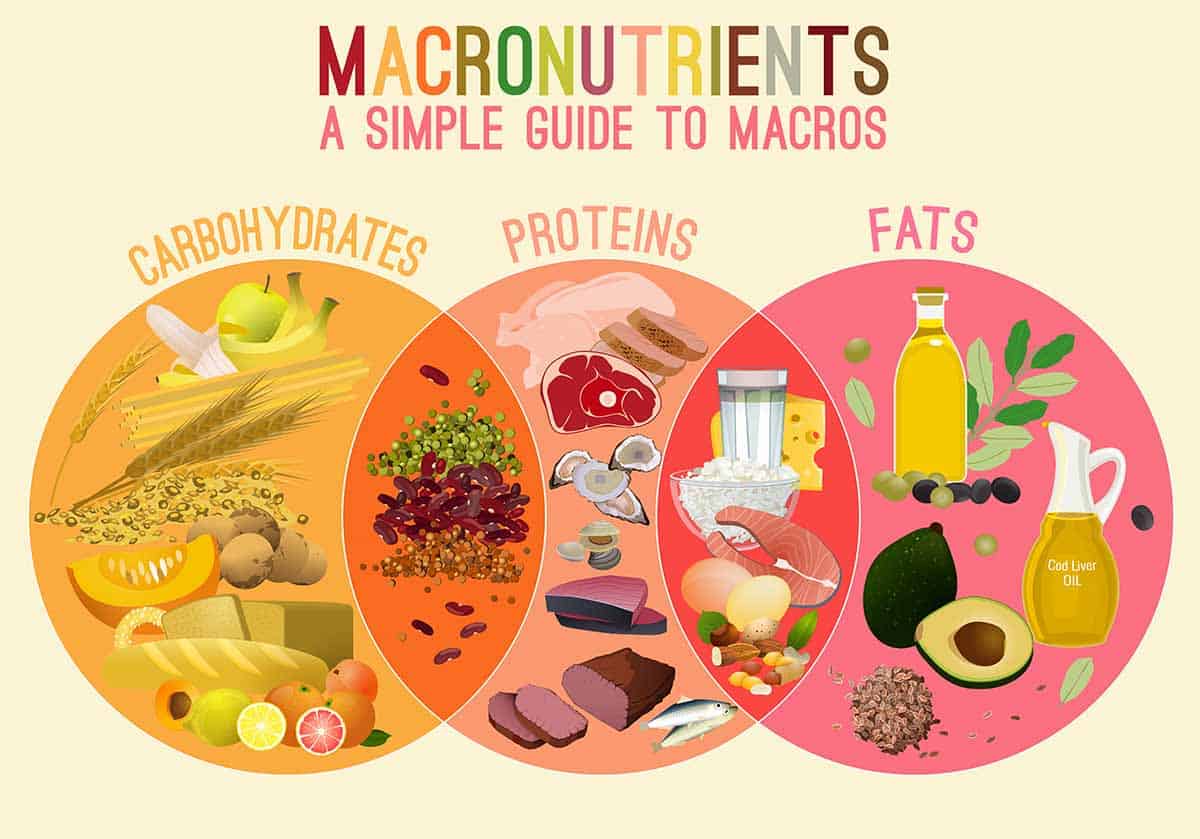It seems these days everyone is talking about their macros. You’ll hear the term tossed around the gym and in the break room. But what are macros, and what do they have to do with nutrition?
Macros in nutrition are any of the three nutrients the human body requires in large quantities, including carbohydrates, protein, and fat. Using specific macro ratios and tracking macro consumption can help some people to improve their health or to lose weight.
In this blog post, we will discuss everything you need to know about macronutrients. We’ll answer questions like why macros are important, how to calculate macros, and does counting macros really work.
Article Contents
What is a Macro in Nutrition?
A macro, or macronutrient, is any of the three essential components of food: protein, carbohydrates and fat. They are called “macros,” which means large because they are required in larger quantities than micronutrients.
The three macronutrients play different essential roles in the body.
- Protein: Protein is a complex molecule made up of amino acids. It is responsible for repairing tissue and building muscle, but it also creates enzymes and hemoglobin, both of which are essential to keep your body running.
- Carbohydrates: Carbs are sugars, starches, and fiber that are turned into glucose by your body and used to give energy to your muscles and your nervous system. Fiber is also essential for a healthy digestive system.
- Fat: Fat is a three-molecule structure called a triglyceride. Even though it has a bad reputation, it is an important part of a healthy diet. Fats provide energy, help your body absorb vitamins, support heart health in the form of Omega 3’s, and they help you feel full and satisfied.
If you want to improve your health, eating the right ratio of macronutrients is important. Too much of any one over the others can negatively impact your health.
Counting macronutrients is one way that people ensure they’re getting adequate nutrition to live long and healthy lives. Some people also use it to lose weight or manage conditions like diabetes.
Why are Macros Important?
Macronutrients are important because without them, the body and mind cannot function. You need protein, carbohydrates, and fats to survive. While counting macros isn’t essential to survival, it can be helpful for optimizing health and losing weight.
Here are some reasons counting macros is important:
- It keeps you healthy. Counting macronutrients ensures that the body is receiving all the nutrients it needs to grow, repair, and maintain itself.
- It makes sure you have plenty of energy. When you’re getting enough macros, you’ll be making sure your body has enough fuel to keep you moving throughout the day.
- It makes you feel satisfied. Getting the right amount of carbs, protein, and fat will help you feel full and satisfied after every meal.
- It can help you lose weight. By eating the right amount of carbs, proteins, and fats, you’re also making sure you’re eating the right amount of food. This helps prevent overeating.
- It enhances performance. For athletes and bodybuilders, counting macros is essential to performance and strength building.
From a health standpoint, tracking your macros is a no brainer! There are so many benefits to reap, but learning how to calculate and keeping up with tracking can be time-consuming.
How Do I Calculate My Macros?
The best way to calculate macros is to use an app like MyFitness Pal, Lose It!, or Cronometer. All of these apps are available for download on iOS and Android. They all work similarly: you log in your food, track it day by day to get a sense of how much you’re eating and working off, and they take care of the rest. They also sometimes will keep track of your micronutrient intake as well!
However, we know you want to see what goes into calculating your macros and how to do it yourself, so let’s dive in.
Calculate How Many Calories You Need in a Day
Figuring out how many calories you need in a day isn’t as simple as you might think, so once again, we recommend using an online calculator to tell you how many calories you’re likely to need in a day, like this one from the Mayo Clinic.
But if you want to figure it out yourself, here’s how.
- Find your BMR (Basal Metabolic Rate). Here is the formula for men and women:
- Men: BMR = 88.362 + (13.397 x weight in kg) + (4.799 x height in cm) – (5.677 x age in years)
- Women: BMR = 447.593 + (9.247 x weight in kg) + (3.098 x height in cm) – (4.330 x age in years)
- Multiply the BMR by the activity modifier.
- If you’re not very active, multiply by 1.3.
- If you do light activity throughout the day, multiply by 1.55.
- If you’re heavily active for at least 2 hours during the day, multiply by 1.65.
- If you’re heavily active for at least 4 hours during the day, multiply by 1.8.
- If you’re heavily active for at least 8 hours during the day, multiply by 2.
- Add or subtract calories if you want to lose or gain weight.
- If you want to lose weight, subtract 200-500 calories depending on your goals.
- If you want to gain weight, add 200-500 calories depending on your goals.
- The result is the number of calories you should be consuming in one day.
Women usually require about 2,000 calories per day to maintain their weight and men typically need about 2,600 calories, but these are truly just estimates.
Pick Your Macronutrient Ratio
There is no one single macronutrient ratio that works for all people. The USDA recommends ratios falling within these ranges:
- Carbohydrate: 45-65%
- Protein: 10-35%
- Fat: 20-35%
You can change the ratios to make them fit your specific goals, depending on what you want out of this diet plan.
Let’s take a quick look at some goal-specific ratios:
Macronutrient Ratio Estimates
Here is the general breakdown of macro ratios for different health-related goals:
| Average Person | For Weight Loss | For Muscle Gain | For Keto | |
|---|---|---|---|---|
| Carbohydrates | 40% | 30% | 60% | 5% |
| Protein | 30% | 40% | 25% | 20% |
| Fat | 30% | 30% | 15% | 75% |
While these ratios are helpful, there is some wiggle room here. If you’re very active, you may want to up the number of carbohydrates during periods of strenuous activity to properly fuel your muscles. If you’re relatively sedentary, you might need fewer carbohydrates.
Additionally, some health conditions like Type 2 Diabetes have specific dietary requirements. You can still track your macros if you have diabetes, but you could consult your doctor or nutritionist about your calorie requirements and which ratio to follow.
Determine How Many Calories of Each Macro You Need
You’ve made it to the last step! All you have to do is divide the calories you can have of each macro by the number of calories in a gram of each macro:
- Carbohydrates: 4 calories per gram
- Proteins: 4 calories per gram
- Fat: 9 calories per gram
So, you would take the numbers you calculated in the previous step and divide them by these numbers above. Let’s continue with the example from above so you can see it in action.
- Carbohydrates: 480 calories / 4 = 120 gram
- Protein: 480 calories / 4 = 120 grams
- Fat: 640 calories / 9 = 71 grams
Now you should have an idea of how many grams of protein, carbohydrate, and fat you should be targeting. All you have to do is track what you eat throughout the day.
Does Counting Macros Really Work?
Counting macros is a valid, reasonable, and effective way to lose weight and improve your overall health. Most people will see results in a few weeks if they follow the appropriate diet plan for their goals.
However, most of the evidence we have about the success of counting macros is anecdotal. There isn’t a ton of research about how counting macros affects our bodies, but there are some studies that show how further study would be promising. For example:
- This study found that a slight increase in protein consumption in aging men (from 6% to 17%) may help prevent Alzheimer’s Disease.
- This study found that a diet with 7% to 15% fat helped reduce body fat percentage.
When it comes to weight loss, counting macros works just as well, and potentially better than counting calories. It is, in essence, a way to restrict or monitor calories consumption. Macro counting is generally seen as healthier because it leads to a more balanced diet than traditional calorie restriction methods.
Outcomes change, however, depending on the macro ratio you’re using. If you’re eating outside of the USDA recommendations, chances are, you’re not improving your health.
Counting macronutrients is also a time-intensive process that is hard to maintain, and many people find it difficult to keep up with.
If you’re considering trying counting macronutrients, there are some things you can do to make it easier.
Here are a few beginner tips to help you get the most out of counting macros:
- Plan out your meals. At the beginning of the week or the month, write out what you plan to eat each day for your main meals and snacks and track the macros ahead of time.
- Meal prep, meal prep, meal prep. Plan out your meals for the week and then prep them as much as possible. Save meals that are easy to freeze for the end of the week, so you don’t have to worry about them going bad.
- Use a food scale to weigh your good. This will allow you to dial in on your macros with precision.
- Check restaurant websites before going out. A lot of restaurants list their nutrition info online. You can decide on what you’re going to get and track it before heading out for the night.
- Try new foods and new recipes. Some of your old favorites might not fit so well into your macro ratios, so take this opportunity to explore new things!
- Don’t stress! If you’re a little over or under on your macros here and there, it isn’t a huge deal. Just do your best and stick with it.
Outro
If you’ve never tried counting your macros and are looking for a way to improve your health, then you should give it a try. Counting macronutrients is an effective way to ensure you’re getting the right amounts of carbs, protein, and fat to energize and nourish your body.




